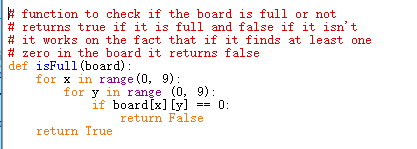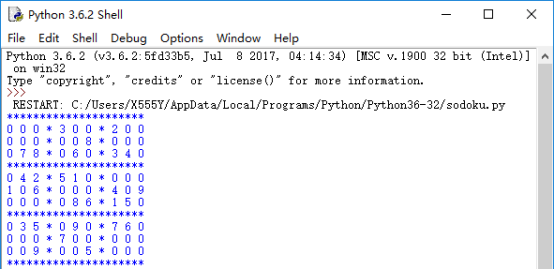Sudoku python
软件工程基础-个人项目-sudoku游戏]

cnblob项目地址
https://github.com/dinodeahonf/Sudoku
解题思路
其目标是用数字填充9×9网格,以便组成网格的9个3×3子网格(也称为“盒”,“块”或“区域”)中的每列,每行和每一个包含所有的数字从1到9.这个益智设置器提供了一个部分完成的网格,这对于一个良好的拼图有一个单一的解决方案。 完成的游戏总是一种拉丁广场,对各个区域的内容有额外的限制。例如,相同的单个整数可能不会在同一行,列或9x9播放板的九个3×3子区域中的任何一个中出现两次
PSP 表格
|
PSP2.1
|
Personal Software Process Stages |
预估耗时(分钟) |
实际耗时(分钟) |
|
Planning |
计划 |
30 |
40 |
|
Estimate |
估计这个任务需要多少时间 |
50 |
50 |
|
Development |
开发 |
90 |
90 |
|
Analysis |
需求分析(包括学习新技术) |
75 |
80 |
|
Design Spec |
生成射进文档 |
25 |
30 |
|
Design Review |
设计复审(和同事审核设计文档) |
40 |
40 |
|
Coding Standard |
代码规范 (为目前的开发制定合适的规范) |
60 |
80 |
|
Design |
具体设计 |
80 |
90 |
|
Coding |
具体编码 |
1300 |
1400 |
|
coding review |
代码复审 |
130 |
140 |
|
Test |
测试(自我测试,修改代码,提交修改) |
100 |
120 |
|
Reporting |
报告 |
70 |
80 |
|
Test Report |
测试报告 |
50 |
50 |
|
Size Management |
计算工作量 |
60 |
60 |
|
Postmortem & Process Improvement Plan |
事后总结,并提出过程进计划 |
40 |
40 |
|
|
合计 |
2200 |
2390 |



覆盖率测试

您可以先阅读游戏介绍。打开这个链接: https://en.wikipedia.org/wiki/Sudoku
Full code:
#file = open("output.txt","w")
# function to print the board on to a file.
# returns a string variable with the board info
def printFileBoard(board):
string = ""
string = string + "*********************\n"
for x in range(0, 9):
if x == 3 or x == 6:
string = string + "*********************\n"
for y in range(0, 9):
if y == 3 or y == 6:
string = string + " * "
string = string + str(board[x][y]) + " "
string = string + "\n"
string = string + "*********************\n"
return string
# function to print the board on to the console
def printBoard(board):
print("*********************")
for x in range(0, 9):
if x == 3 or x == 6:
print("*********************")
for y in range(0, 9):
if y == 3 or y == 6:
print("*", end=" ")
print(board[x][y], end=" ")
print()
print("*********************")
# function to check if the board is full or not
# returns true if it is full and false if it isn't
# it works on the fact that if it finds at least one
# zero in the board it returns false
def isFull(board):
for x in range(0, 9):
for y in range (0, 9):
if board[x][y] == 0:
return False
return True
# function to find all of the possible numbers
# which can be put at the specifies location by
# checking the horizontal and vertical and the
# three by three square in which the numbers are
# housed
def possibleEntries(board, i, j):
possibilityArray = {}
for x in range (1, 10):
possibilityArray[x] = 0
#For horizontal entries
for y in range (0, 9):
if not board[i][y] == 0:
possibilityArray[board[i][y]] = 1
#For vertical entries
for x in range (0, 9):
if not board[x][j] == 0:
possibilityArray[board[x][j]] = 1
#For squares of three x three
k = 0
l = 0
if i >= 0 and i <= 2:
k = 0
elif i >= 3 and i <= 5:
k = 3
else:
k = 6
if j >= 0 and j <= 2:
l = 0
elif j >= 3 and j <= 5:
l = 3
else:
l = 6
for x in range (k, k + 3):
for y in range (l, l + 3):
if not board[x][y] == 0:
possibilityArray[board[x][y]] = 1
for x in range (1, 10):
if possibilityArray[x] == 0:
possibilityArray[x] = x
else:
possibilityArray[x] = 0
return possibilityArray
# recursive function which solved the board and
# prints it.
def sudokuSolver(board):
i = 0
j = 0
possiblities = {}
# if board is full, there is no need to solve it any further
if isFull(board):
print("Board Solved Successfully!")
printBoard(board)
return
else:
# find the first vacant spot
for x in range (0, 9):
for y in range (0, 9):
if board[x][y] == 0:
i = x
j = y
break
else:
continue
break
# get all the possibilities for i,j
possiblities = possibleEntries(board, i, j)
# go through all the possibilities and call the the function
# again and again
for x in range (1, 10):
if not possiblities[x] == 0:
board[i][j] = possiblities[x]
#file.write(printFileBoard(board))
sudokuSolver(board)
# backtrack
board[i][j] = 0
def main():
SudokuBoard = [[0 for x in range(9)] for x in range(9)]
SudokuBoard[0][0] = 0
SudokuBoard[0][1] = 0
SudokuBoard[0][2] = 0
SudokuBoard[0][3] = 3
SudokuBoard[0][4] = 0
SudokuBoard[0][5] = 0
SudokuBoard[0][6] = 2
SudokuBoard[0][7] = 0
SudokuBoard[0][8] = 0
SudokuBoard[1][0] = 0
SudokuBoard[1][1] = 0
SudokuBoard[1][2] = 0
SudokuBoard[1][3] = 0
SudokuBoard[1][4] = 0
SudokuBoard[1][5] = 8
SudokuBoard[1][6] = 0
SudokuBoard[1][7] = 0
SudokuBoard[1][8] = 0
SudokuBoard[2][0] = 0
SudokuBoard[2][1] = 7
SudokuBoard[2][2] = 8
SudokuBoard[2][3] = 0
SudokuBoard[2][4] = 6
SudokuBoard[2][5] = 0
SudokuBoard[2][6] = 3
SudokuBoard[2][7] = 4
SudokuBoard[2][8] = 0
SudokuBoard[3][0] = 0
SudokuBoard[3][1] = 4
SudokuBoard[3][2] = 2
SudokuBoard[3][3] = 5
SudokuBoard[3][4] = 1
SudokuBoard[3][5] = 0
SudokuBoard[3][6] = 0
SudokuBoard[3][7] = 0
SudokuBoard[3][8] = 0
SudokuBoard[4][0] = 1
SudokuBoard[4][1] = 0
SudokuBoard[4][2] = 6
SudokuBoard[4][3] = 0
SudokuBoard[4][4] = 0
SudokuBoard[4][5] = 0
SudokuBoard[4][6] = 4
SudokuBoard[4][7] = 0
SudokuBoard[4][8] = 9
SudokuBoard[5][0] = 0
SudokuBoard[5][1] = 0
SudokuBoard[5][2] = 0
SudokuBoard[5][3] = 0
SudokuBoard[5][4] = 8
SudokuBoard[5][5] = 6
SudokuBoard[5][6] = 1
SudokuBoard[5][7] = 5
SudokuBoard[5][8] = 0
SudokuBoard[6][0] = 0
SudokuBoard[6][1] = 3
SudokuBoard[6][2] = 5
SudokuBoard[6][3] = 0
SudokuBoard[6][4] = 9
SudokuBoard[6][5] = 0
SudokuBoard[6][6] = 7
SudokuBoard[6][7] = 6
SudokuBoard[6][8] = 0
SudokuBoard[7][0] = 0
SudokuBoard[7][1] = 0
SudokuBoard[7][2] = 0
SudokuBoard[7][3] = 7
SudokuBoard[7][4] = 0
SudokuBoard[7][5] = 0
SudokuBoard[7][6] = 0
SudokuBoard[7][7] = 0
SudokuBoard[7][8] = 0
SudokuBoard[8][0] = 0
SudokuBoard[8][1] = 0
SudokuBoard[8][2] = 9
SudokuBoard[8][3] = 0
SudokuBoard[8][4] = 0
SudokuBoard[8][5] = 5
SudokuBoard[8][6] = 0
SudokuBoard[8][7] = 0
SudokuBoard[8][8] = 0
printBoard(SudokuBoard)
sudokuSolver(SudokuBoard)
#file.close()
if __name__ == "__main__":
main()
小结
这次个人项目对我来说有点麻烦。因为用python的能力没那么厉害。起初,我想用C语言来写,但在写代码有点麻烦,也没那么厉害。然后我使用python来写。完成作业后,我得到了很多知识,用python的能力提高了一点点。



 浙公网安备 33010602011771号
浙公网安备 33010602011771号